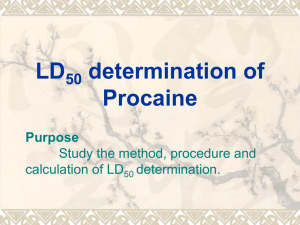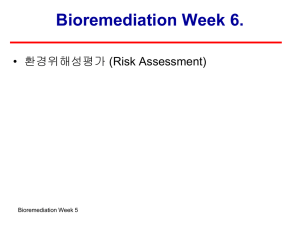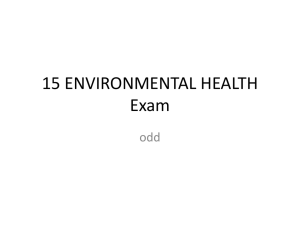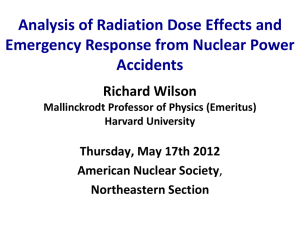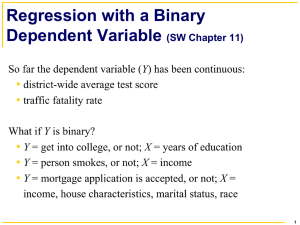Presentation - Alliance for Risk Assessment
advertisement
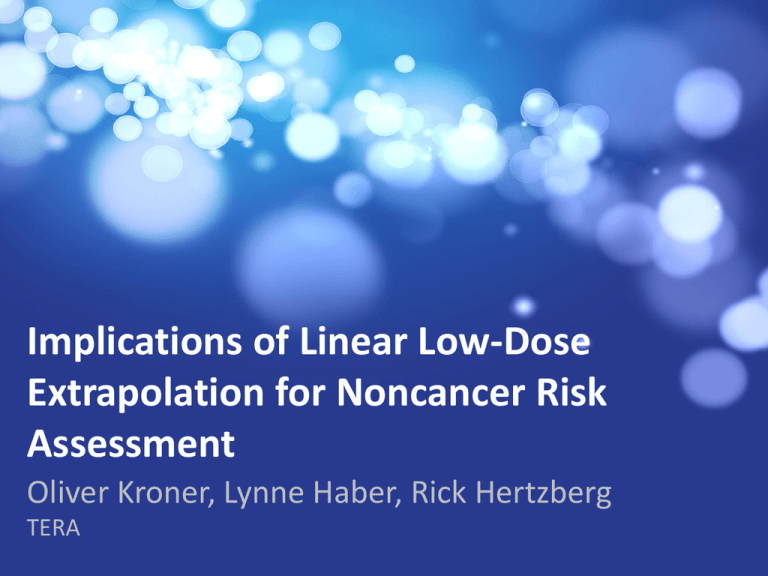
Implications of Linear Low-Dose Extrapolation for Noncancer Risk Assessment Oliver Kroner, Lynne Haber, Rick Hertzberg TERA **This case study is a characterization of the method, and is not intended as endorsement or opposition of linear extrapolation. Method 1: extend a straight line from the chosen BMDL adjusted to the human equivalent dose or concentration (HED or HEC). Method 2: linearize HED(C) dose-response data using probit transformation in logarithmic space. Fit regression line to the data and extend to the lowdose Response Method 1: Linear extrapolation from BMD Human Equivalent Dose 0.1 UFA Dose UFD UFS Animal BMD Results • Strengths: • simplicity • Provides Risk Specific Dose at any level of exposure • Weaknesses: • Risk estimates produced were highly conservative compared to current RfC/RfD methods • No consideration of biological understanding Panel Comments • Possibly useful for screening level assessment or priority setting, but should not be construed as accurate estimate of risk • Requested exploration of non-cancer linear extrapolation in log-dose, probit space Probit Transformation • Linearizes biological data • requires quantal population data • To allow graphing in log space, response rates were converted to Excess Risk [added risk(d) = P(d) - P(0)] for each dose group • a dataset of at least three test doses above the control From Casarett & Doull 2009 Probit Response Method 2: Linear extrapolation in LogDose, Probit Space Animal Data Human Equivalent Dose 5 UFA UFD Log Dose UFS Acrylamide Effect: Nerve Degeneration Species: Rat RfD = 0.002 mg/kg-day Log(RfD) = -2.69 Uncertainty Factor: 30 (A-3; H-10) Probit Response Above Control v. Log(Human Equivalent Dose) (mg/kg) Probit at RfD = 1.9 Risk at the RfD = 1 x 10-3 Summary of Results Method 1. Linear Extrapolation from BMD(L) Chemical Oral Risk at RfC/RfD Risk at RfC/RfD From BMD(C)L (Method 1) From BMD(C) (Method 4) Method 2. Log-Dose, Probit Risk at RfC/RfD Number of Dose Groups (other than control) Acrylamide 1 x 10-2 3 x 10-4 1 x 10-3 3 Chlordecone 1 x 10-2 1 x 10-5 2 x 10-3 4 1,3Dichloropropene 8 x 10-3 6 x 10-4 2 x 10-12 3 Nitrobenzene 1 x 10-2 4 x 10-3 5 x 10-1 3 Inhalation Conclusions • Simple • Provides estimate of risk at any level of exposure But, • Limited Applicability: – Restrictive data requirements permitted the use of four of the 25 chemicals considered • Inconsistent Results: – Risk estimates at the RfD/RfC ranged from 1 x 10-12 (1,3-dichloropropene) to 0.5 (nitrobenzene). Extra Slides Areas of Uncertainty to Consider in Noncancer Dose Response Assessment Sub-chronic Animal Response Chronic Human Chronic Animal Reproductive UFL UFS 0.1 PBPK UFH UFD UFA Dose Calculation of Human Equivalence Dose or Concentration • Method 1 Benchmark Dose 95% Lower-bound confidence limit (BMDL) Uncertainty Factors: UFS, UFA, and UFD • Method 2 Benchmark Dose (BMD) Uncertainty Factors: UFS, UFA, and UFD • Method 3. Benchmark Dose (BMD) Uncertainty Factors: geometric means of the UFS, UFA, and UFD • Method 4. Benchmark Dose (BMD) Uncertainty Factors: geometric mean of the UFA


